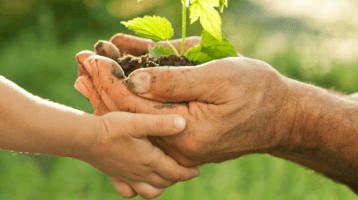Why has biodiversity varied over time?
Biodiversity has changed enormously over millennia. For a long time, changes were the result of natural causes, such as catastrophes, changes in living conditions, or micro-changes that took millions of years to take effect. But over the last two hundred years or so, the acceleration in biodiversity loss has been unprecedented and has been caused by the actions of just one thing: humans.
Variations in biodiversity over time
The natural cycle of all our planet’s ecosystems is a balanced one in which species are born at the same rate and in the same quantities as those that disappear. This careful balance has been relatively stable with little variation over time.
However, over the last six hundred million years, the number of species has increasingly varied and shifted towards depletion. Species are now disappearing a thousand times faster than if they were simply disappearing naturally, leaving no time for new species to appear.
Biodiversity experienced its first variations without any human influence, caused by numerous natural phenomena, such as falling asteroids, natural changes in the climate and ocean currents, massive volcanic eruptions, etc.
How has human activity affected biodiversity?
Today, there are around two million living species on the planet, but as scientists are at pains to remind us, there could be fifty times more than that! As part of the natural cycle and over the centuries, it’s estimated that three or four species naturally disappear in any given year. As of today, the International Union for Conservation of Nature (IUCN) has estimated the proportion of species that are under threat:
- 70% of plants
- 32% of fish
- 30% of amphibians
- 28% of reptiles
- 21% of mammals
- 12% of birds
Different causes of variation
Humans are responsible for the disappearance of many species, hastening the weakening of biodiversity through various interactions with the environment.
Lifestyles that don’t respect the environment
Ever since the industrial revolution and up to the 19th century, the way industrialised nations choose to live has been the cause of the serious environmental crisis we’re experiencing today. Excessive consumption, massive waste, water, air and soil pollution, noise pollution... our everyday habits and behaviour are putting the environment under enormous strain and threatening everything that relies on it.
Building and tarmacking roads, changing the landscape and drying out watercourses all leave the inhabitants of the natural world neither the time nor the opportunities to adapt. They simply disappear.
Land clearing and deforestation
On planet Earth, some people consume far too much, while others find it hard to feed themselves. Developing countries are faced with urgent problems in terms of nutrition, housing, access to drinking water, security and more. Intensive farming practices have been introduced, clearing and razing forests, as a way to exploit more land, destroying many of the ecosystems that are essential to the planet’s equilibrium. Desertification of the Sahel region, for example, has been caused by massive land clearing and deforestation, a major contributor to global warming. Whether it’s overmining, the exotic wood trade or water exploitation, natural resources are also being depleted, contributing to the disappearance of species.
The introduction of invasive plants
A less well-known but equally important phenomenon is the invasion of “exotic plants”, another key factor in the impoverishment of biodiversity.
Global trade has introduced exotic plants into countries that are complete strangers to the local ecosystems where they become established. In already fragile environments, plants will develop to the detriment of other species, colonising the area and causing certain species to disappear altogether.
This colonisation applies to both plants, such as the butterfly bush, and animals, such as the American crayfish in European streams. From predators to micro-organisms, all living things are affected by colonisation, and if they’re weakened, they simply won’t be able to adapt in time. And the disappearance of one species can lead to the disappearance of others.
All species are interdependent – that’s what biodiversity is all about!

WHAT IS BIODIVERSITY?
A big word for a big concept! Biodiversity is a relatively recent term in the context of life on Earth, but what exactly does it mean? Klorane Botanical Foundation can help you see more clearly.

BIODIVERSITY OF THE FUTURE
Our planet is a fragile balance. Biodiversity loss – although not reversible – can potentially be stopped in its tracks. We need to become more aware of its importance, constantly raise awareness, and never stop trying to protect it.

PRESERVING BIODIVERSITY
We urgently need to take steps to protect biodiversity, given our ability to ensure our survival on the planet – and that of future generations – depends on it. But why is biodiversity in such danger? And what can we do to help preserve it?
